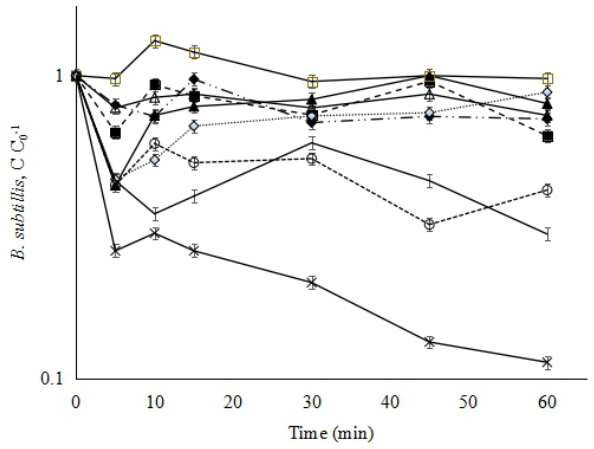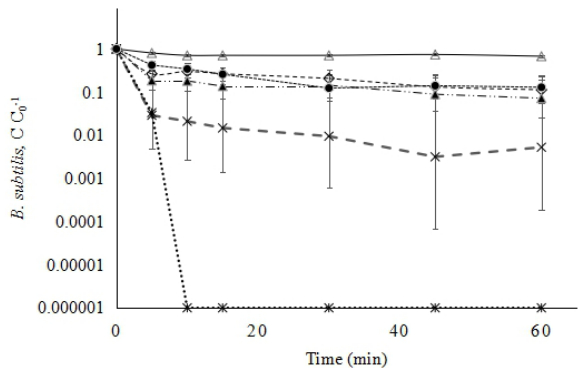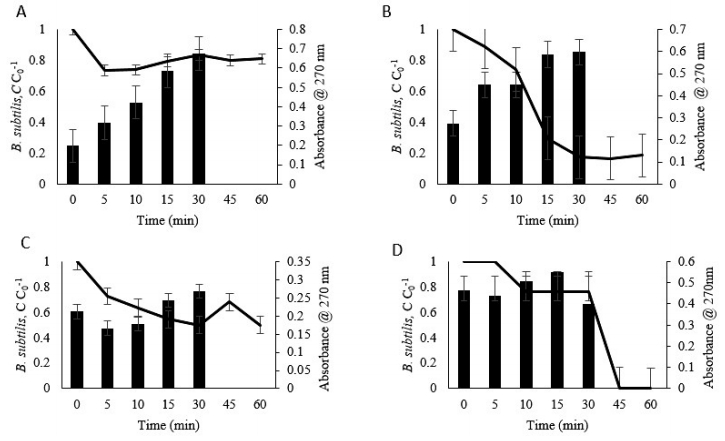|
[1]
|
Bandala ER, Gonzalez L, De la Hoz F, et al. (2011) Application of azo dyes as dosimetric indicators for enhanced photocatalytic solar disinfection (ENPOSODIS). J Photochem Photobiol A Chem 218: 185-191. doi: 10.1016/j.jphotochem.2010.12.016

|
|
[2]
|
Mañas P, Pagán R (2005) Microbial inactivation by new technologies of food preservation. J Appl Microbiol 98: 1387-1399. doi: 10.1111/j.1365-2672.2005.02561.x

|
|
[3]
|
Bandala ER, Castillo-Ledezma JH, González L, et al. (2011) Solar driven advanced oxidation processes for inactivation of pathogenic microorganisms in water. Recent Res Dev Photochem Photobiol 8: 1-16.
|
|
[4]
|
Aurioles-Lopez V, Polo-Lopez MI, Fernandez-Ibanez P, et al. (2015) Effect of iron salt counter ion in dose-response curves for inactivation of Fusarium solani in water through solar driven Fenton-like processes. Phys Chem Earth 91: 46-52.
|
|
[5]
|
Bandala ER, Perez R, Velez-Lee AE, et al. (2011) Bacillus subtilis spore inactivation in water using Photo assisted Fenton reactions. Sustain Environ Res 21: 285-290.
|
|
[6]
|
Bandala ER, Gonzalez L, Sanchez-Salas JL, et al. (2012) Inactivation of Ascaris eggs in water using sequential solar driven photo-Fenton and free chlorine. J Water Health 10: 20-30. doi: 10.2166/wh.2011.034

|
|
[7]
|
Bandala ER, Raichle BW (2013) Solar driven advanced oxidation processes for water decontamination and disinfection, in: N. Enteria, A. Akbarsadeh (Eds.), Solar Energy Sciences and Engineering Applications, CRC Press, London, UK, 395-412.
|
|
[8]
|
Driks A (1999) Bacillus subtilis spore coat. Microbiol Mol Biol Rev 63: 1-20.
|
|
[9]
|
Driks A (2002) Maximum shields: the assembly and function of the bacterial spore coat. Trends Microbiol 10: 251-254. doi: 10.1016/S0966-842X(02)02373-9

|
|
[10]
|
Henriques AO, Moran CP (2007) Structure, assembly and function of the spore surface layers. Annu Rev Microbiol 61: 555-588. doi: 10.1146/annurev.micro.61.080706.093224

|
|
[11]
|
McKenney PT, Driks A, Eskandarian HA, et al. (2010) A distance weighted interaction map reveals a previously uncharacterized layer of the Bacillus subtilis spore coat. Curr Biol 20: 934-938. doi: 10.1016/j.cub.2010.03.060

|
|
[12]
|
Takamatsu H, Imamura D, Kuwana R, et al. (2009) Expression of yeeK during Bacillus subtilis sporulation and localization of YeeK to the inner spore coat using fluorescence microscopy. J Bacteriol 191: 1220-1229. doi: 10.1128/JB.01269-08

|
|
[13]
|
McKenney PT, Eichenberger P (2012) Dynamics of spore coat morphogenesis in Bacillus subtilis Molecular Microbiol. 83: 245-260
|
|
[14]
|
Ghosh S, Setlow B, Wahome PG, et al. (2008). Characterization of spores of Bacillus subtilis that lack most coat layers. J Bacteriol 190: 6741-6748. doi: 10.1128/JB.00896-08

|
|
[15]
|
Shapiro M, Setlow B, Setlow P (2004) Studies on the killing of spores of Bacillus subtilis by a modified Fenton reagent containing CuCl2 and ascorbic acid. Appl Environ Microbiol 70: 2535-2539. doi: 10.1128/AEM.70.4.2535-2539.2004

|
|
[16]
|
Paidhungat M, Ragkousi K, Setlow P (2001) Genetic requirements for induction of germination of spores of Bacillus subtilis by Ca2-dipicolinate. J Bacteriol 183: 4886-4893. doi: 10.1128/JB.183.16.4886-4893.2001

|
|
[17]
|
Setlow B, Setlow P (1996) Role of DNA repair in Bacillus subtilis spore resistance. J Bacteriol 178: 3486-3495 doi: 10.1128/jb.178.12.3486-3495.1996

|
|
[18]
|
Sanchez-Salas JL, Setlow P (1993) Proteolytic processing of the protease which initiates degradation of small, acid-soluble proteins during germination of Bacillus subtilis spores. J Bacteriol 175: 2568-2577. doi: 10.1128/jb.175.9.2568-2577.1993

|
|
[19]
|
Marinas BJ, Larson MA (2003) Inactivation of Bacillus subtilis spores with ozone and monochloramine. Water Res 37: 833-844. doi: 10.1016/S0043-1354(02)00381-0

|
|
[20]
|
Huesca-Espitia LC, Aureoles V, Ramirez I, et al. (2017) Photocatalytic inactivation of highly resistant microorganisms in water: A kinetic approach. J Photochem Photobiol A Chem 337: 132-139. doi: 10.1016/j.jphotochem.2017.01.025

|
|
[21]
|
Bandala ER, Corona-Vasquez B, Guisar R, et al. (2009). Deactivation of highly resistant microorganisms in water using solar driven photocatalytic processes. J Chem React Engin 7: A7.
|
|
[22]
|
Bandala ER, Castillo JH, González L, et al. (2011) Solar driven advanced oxidation processes for inactivation of pathogenic microorganisms in water, In: PANDALAI S.G. Author, Recent Research Developments in Photochemistry & Photobiology Transworld Research Network. Kerala, India. 8: 1-16.
|
|
[23]
|
Bandala ER, Pérez R, Velez AE, et al. (2011) Bacillus subtilis spore inactivation in water using photo-assisted Fenton reaction. Sustainable Environ Res 21: 285-290.
|
|
[24]
|
Corona-Vasquez B, Guisar R, Herrera MI, et al. (2007) Inactivation of waterborne pathogens using solar photocatalysis. J Adv Ox Tech 10: 435-438.
|
|
[25]
|
Setlow P (2003) Spore germination. Curr Opin Microbiol 6: 550-556. doi: 10.1016/j.mib.2003.10.001

|
|
[26]
|
Melly E, Genest PC, Gilmore ME, et al. (2002) Analysis of the properties of spores of Bacillus subtilis prepared at different temperatures. J Appl Microbiol 92: 1105-1115. doi: 10.1046/j.1365-2672.2002.01644.x

|
|
[27]
|
Young SB, Setlow P (2004) Mechanisms of killing of Bacillus subtilis spores by Decon and OxoneTM, two general decontaminants for biological agents. J Appl Microbiol 96: 289-301. doi: 10.1046/j.1365-2672.2004.02159.x

|
|
[28]
|
Corona-Vasquez B, Aurioles V, Bandala ER (2012) Solar drinking water generation by solar-driven Fenton-like processes. In: E.B. Babatunde (Ed.) Solar Radiation. InTech Press (ISBN: 978-953-51-0384-4).
|
|
[29]
|
Zepp RG, Faust BC, Hoigne J (1992) Hydroxyl radical formation in aqueous reactions (pH 3-8) of iron (II) with hydrogen peroxide: the photo-Fenton reaction. Environ Sci Technol 26: 313-319. doi: 10.1021/es00026a011

|
|
[30]
|
Leggett MJ, McDonnel G, Denyer SP, et al. (2012) Bacterial spores structures and their protective role in biocide resistance. J Appl Microbiol 113: 485-498. doi: 10.1111/j.1365-2672.2012.05336.x

|
|
[31]
|
Setlow P (2006) Spores of Bacillus subtilis: their resistance to and killing by radiation, heat and chemicals. J Appl Microbiol 101: 514-525. doi: 10.1111/j.1365-2672.2005.02736.x

|
|
[32]
|
Loshon CA, Melly E, Setlow B, et al. (2001) Analysis of killing of spores of Bacillus subtilis by a new disinfectant, Sterilox®. J Appl Microbiol 91: 1051-1058. doi: 10.1046/j.1365-2672.2001.01473.x

|
|
[33]
|
Genest PC, Setlow B, Melly E, et al. (2002) Killing of spores of Bacillus subtilis by peroxynitrite appears to be caused by membrane damage. Microbiol 148: 307-314. doi: 10.1099/00221287-148-1-307

|
|
[34]
|
Coleman WH, Chen D, Li Y.-Q., et al. (2007) How moist heat kills spores of Bacillus subtilis. J Bacteriol 189: 8458-8466. doi: 10.1128/JB.01242-07

|

















 DownLoad:
DownLoad:








